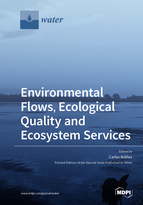Environmental Flows, Ecological Quality and Ecosystem Services
A special issue of Water (ISSN 2073-4441). This special issue belongs to the section "Biodiversity and Functionality of Aquatic Ecosystems".
Deadline for manuscript submissions: closed (30 November 2020) | Viewed by 36788
Special Issue Editor
Interests: climate resilience; coastal management; aquatic ecology; water resources; rice production; nature-based solutions
Special Issues, Collections and Topics in MDPI journals
Special Issue Information
Dear Colleagues,
Establishing proper environmental flows (e-flows) across river basins is one of the keystones to implement an integrated management of water resources. This is even more critical in water scarce river basins due to increasing water uses (i.e., irrigation) and climate change. Functions and values of aquatic ecosystems (i.e., water quality, sediment dynamics, productivity, biodiversity, ecosystem services, etc.) are influenced by river flow regime alterations. However, scientists and managers often find very difficult to quantitatively link the ecological status of aquatic ecosystems and their services to specific e-flow regimes. This Special Issue welcomes papers investigating the links among river flows, the status of aquatic ecosystems and the benefits they provide to our society, either from the science or management perspectives.
Dr. Carles Ibáñez
Guest Editor
Manuscript Submission Information
Manuscripts should be submitted online at www.mdpi.com by registering and logging in to this website. Once you are registered, click here to go to the submission form. Manuscripts can be submitted until the deadline. All submissions that pass pre-check are peer-reviewed. Accepted papers will be published continuously in the journal (as soon as accepted) and will be listed together on the special issue website. Research articles, review articles as well as short communications are invited. For planned papers, a title and short abstract (about 100 words) can be sent to the Editorial Office for announcement on this website.
Submitted manuscripts should not have been published previously, nor be under consideration for publication elsewhere (except conference proceedings papers). All manuscripts are thoroughly refereed through a single-blind peer-review process. A guide for authors and other relevant information for submission of manuscripts is available on the Instructions for Authors page. Water is an international peer-reviewed open access semimonthly journal published by MDPI.
Please visit the Instructions for Authors page before submitting a manuscript. The Article Processing Charge (APC) for publication in this open access journal is 2600 CHF (Swiss Francs). Submitted papers should be well formatted and use good English. Authors may use MDPI's English editing service prior to publication or during author revisions.
Keywords
- river flow
- aquatic ecosystems
- water quality
- biological indicators
- water uses
- water scarcity
- natural capital






